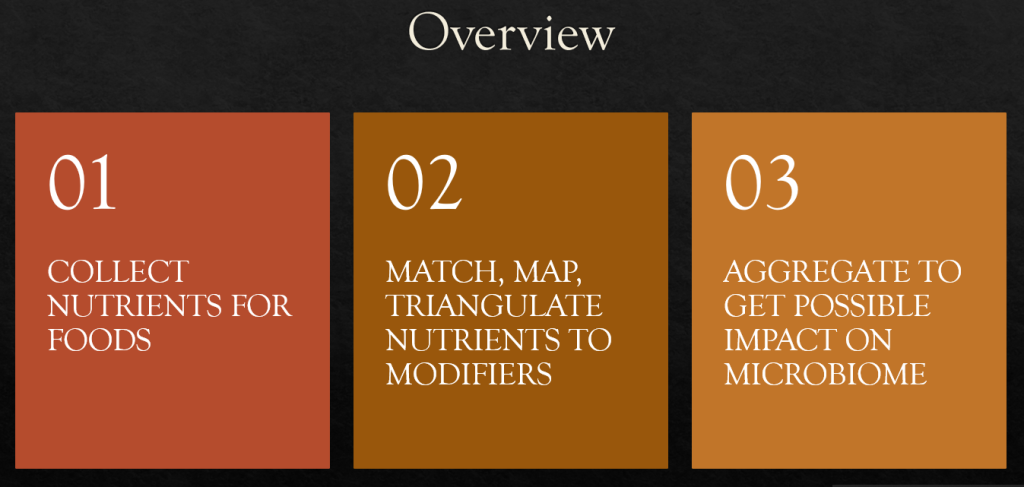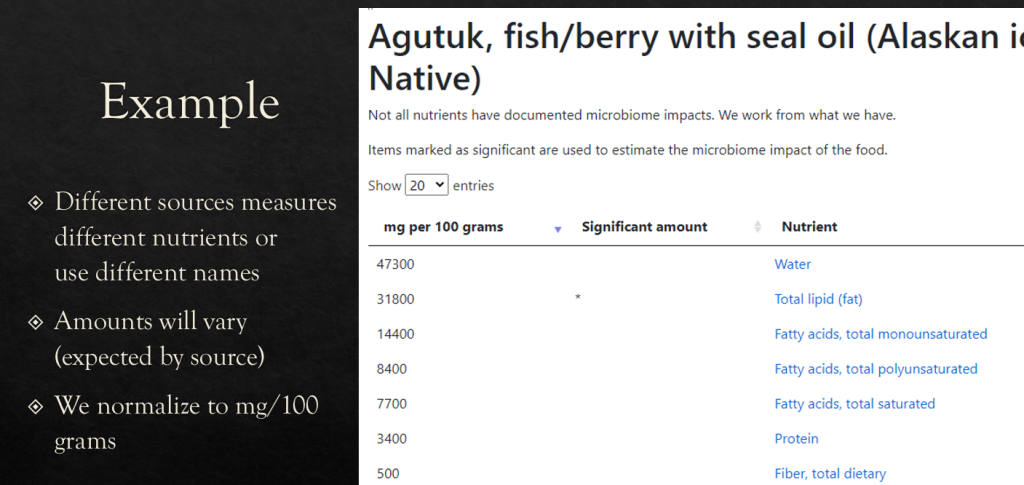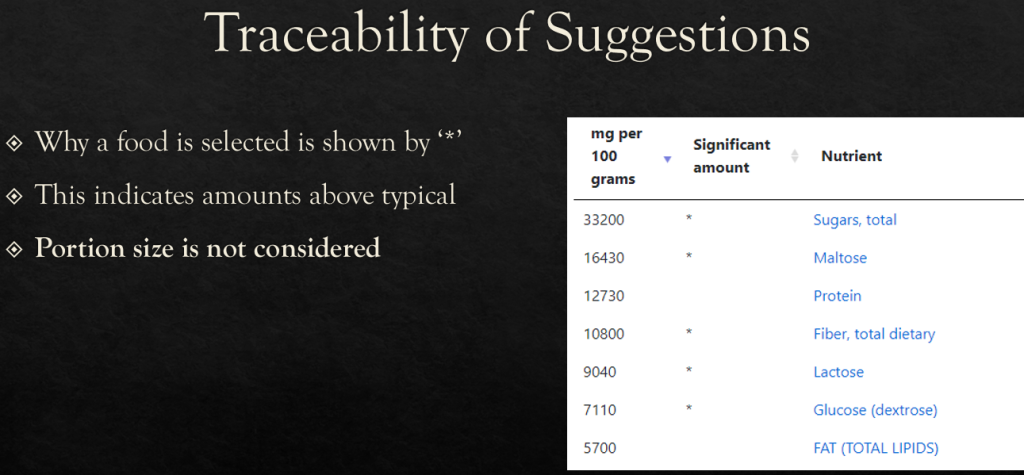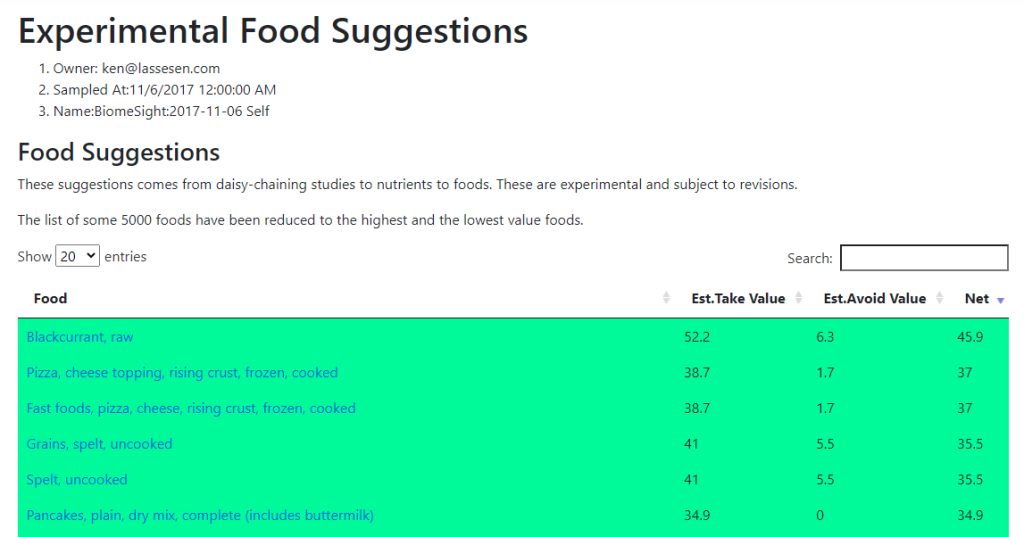This is a reader with a diagnosis of Crohn’s diseases with complications (severe histamine and mast cell issues, severe multiple chemical sensitivity). She also have had ongoing hot flashes for a few decase The Crohn’s has been stabled and does not require prescription medications; it has been treated by diet and the use of E.Coli probiotics (Symbioflor-2: SOURCES: https://www.paulsmarteurope.com/ and https://www.naturitas.us/, and Mutaflor). When a flare starts, the E.Coli probiotics have been able to quiet things down quickly.
Using the new Food Suggestions (with consensus)
This is a new feature that is intended to supplement the first class suggestions from microbiome prescription. Almost 8000 different foods are evaluated. The intent is to allow people to fine tune diets for the most impact especially when flavonoids and sugar types are given by name, but not by what food contains them. Some foods may have both good and bad content, the intent is do a deep evaluation of the foods based on their reported nutrients. For more information, see this blog post.
Overview of Samples
The general impression of the samples is reasonable stableness. Some third party criteria improved (Metagnomics, Xenogeme) and other third party criteria (Medivere,MyBioma,Nirvana) got worst, and one with no change(JasonH). The same is seen with the statistical ranges.
| Criteria | 2022 | 2021 | 2020 |
| Lab Read Quality | 3 | 4.1 | 3.8 |
| Bacteria Reported By Lab | 524 | 584 | 721 |
| Bacteria Over 99%ile | 5 | 9 | 6 |
| Bacteria Over 95%ile | 30 | 44 | 36 |
| Bacteria Over 90%ile | 52 | 82 | 84 |
| Bacteria Under 10%ile | 45 | 25 | 26 |
| Bacteria Under 5%ile | 15 | 10 | 4 |
| Bacteria Under 1%ile | 0 | 0 | 0 |
| Lab: Thryve | |||
| Rarely Seen 1% | 8 | 4 | 9 |
| Rarely Seen 5% | 27 | 29 | 51 |
| Pathogens | 29 | 33 | 28 |
| Outside Range from JasonH | 7 | 7 | 7 |
| Outside Range from Medivere | 15 | 15 | 14 |
| Outside Range from Metagenomics | 10 | 10 | 12 |
| Outside Range from MyBioma | 13 | 13 | 12 |
| Outside Range from Nirvana/CosmosId | 23 | 23 | 14 |
| Outside Range from XenoGene | 40 | 40 | 49 |
| Outside Lab Range (+/- 1.96SD) | 31 | 22 | 18 |
| Outside Box-Plot-Whiskers | 138 | 109 | 142 |
| Outside Kaltoft-Møldrup | 184 | 163 | 205 |
| Condition Est. Over 99%ile | 0 | 0 | 0 |
| Condition Est. Over 95%ile | 1 | 2 | 1 |
| Condition Est. Over 90%ile | 1 | 2 | 1 |
| Enzymes Over 99%ile | 3 | 9 | 0 |
| Enzymes Over 95%ile | 32 | 64 | 23 |
| Enzymes Over 90%ile | 65 | 194 | 71 |
| Enzymes Under 10%ile | 136 | 45 | 68 |
| Enzymes Under 5%ile | 42 | 21 | 37 |
| Enzymes Under 1%ile | 0 | 4 | 0 |
| Compounds Over 99%ile | 26 | 14 | 21 |
| Compounds Over 95%ile | 122 | 29 | 29 |
| Compounds Over 90%ile | 350 | 38 | 37 |
| Compounds Under 10%ile | 149 | 24 | 22 |
| Compounds Under 5%ile | 31 | 17 | 18 |
| Compounds Under 1%ile | 4 | 6 | 6 |
Looking at Special Studies:
- 2020 – 7%- 21% matched, 38%ile against PubMed Criteria
- 2021 – 5% – 18% matched, 32%ile against PubMed Criteria
- 2022 – 5% – 16% matched, 74%ile against PubMed Criteria
The top common ones across the years are:
- Poor gut motility
- ME/CFS without IBS
- Easily irritated
- Post-exertional malaise
- Depression
We do not have sufficient samples yet to do a special study for Crohn’s disease.
There appears to be a weak indication of worsening — this may be due to not being able to get Mutaflor (E.Coli Nissle 1917) during COVID restrictions. This was remedied shortly after the last sample.
Going Forward
Doing the usual three statistical methods (Standard Lab Ranges (+/- 2 Std Dev), Box Plot Whisker, Kaltoft-Moltrup Normal Ranges) to get suggestions (including prescription drugs). I included prescription drugs to see if any typical Crohn’s drugs are suggested.
- risperidone: was the top one, this is used to treat mood disorder (depression and irritability bacteria?)
- hexestrol: a nonsteroidal estrogen which was previously used for estrogen replacement therapy (hot flashes)
- ethopropazine hydrochloride: a drug uses for Parkinson’s disease. A blood family member had Parkinson’s and the person has seen the occasion “shake” in her hands that has raised concerns about that condition
- The next items were antibiotics and significantly less confidence.
This is not totally surprising that prescription items appear to match conditions. The mechanism of action of these prescription drugs may be partially thru the microbiome.
Returning to the non-prescription world, in terms of priorities:
- l-glutamine
- Exercise
- ibuprofen
- gluten-free diet
- thiamine hydrochloride (vitamin B1)
- melatonin supplement
- vegetable/fruit juice-based diets
- Vitamin B-12
- Arbutin (polyphenol) – for a list of foods containing
- artemisinin,(prescription) – i.e. Wormwood derivative
- diosmin,(polyphenol)
- pyridoxine hydrochloride (vitamin B6)
- retinoic acid,(Vitamin A derivative)
- luteolin (flavonoid) – for a list of foods containing
- N-Acetyl Cysteine (NAC),
- oolong teas
- Hesperidin (polyphenol) – for a list of food containing
- extra virgin olive oil
In one sense, the reader was very pleased with these suggestions being almost entirely supplements. The histamine issues greatly restricts her food choices (she is already gluten free!)
Food Suggestions
I did a walk thru of the food suggestions for this sample. See the video below.













Recent Comments